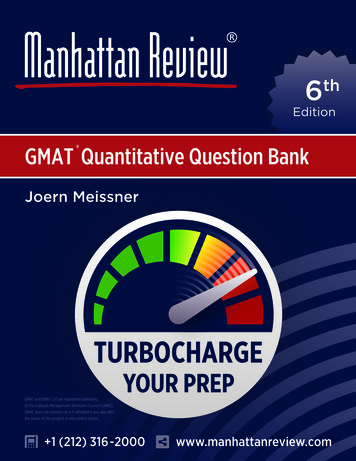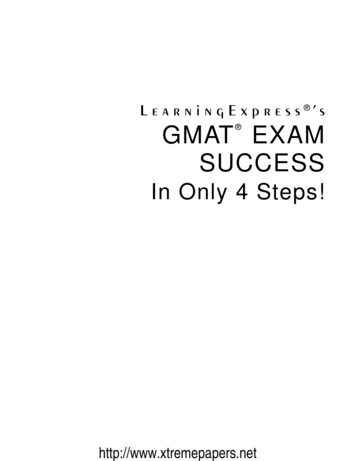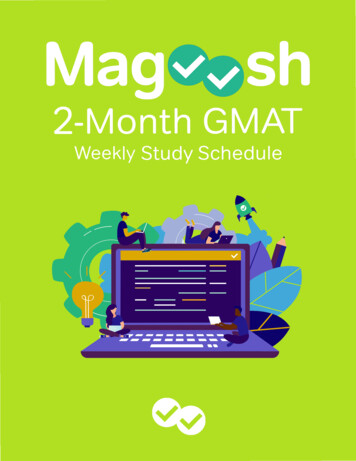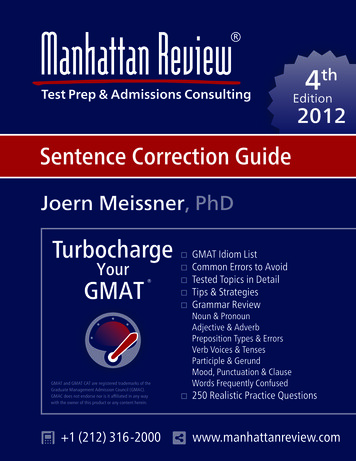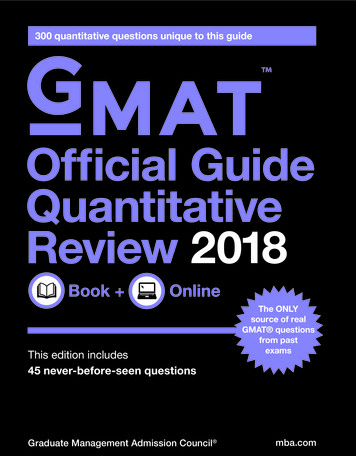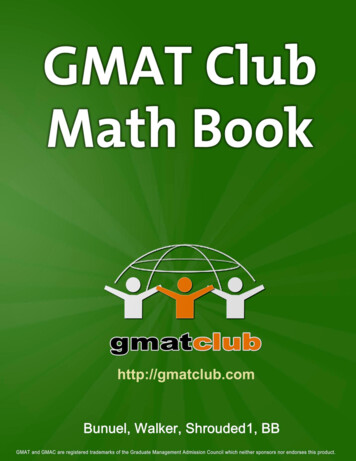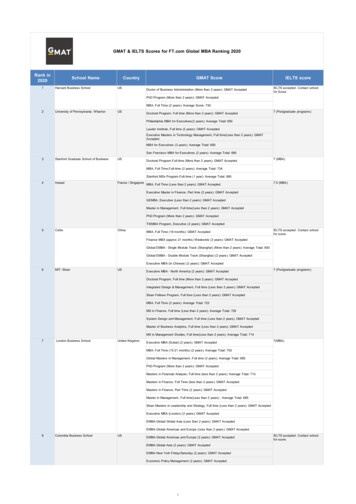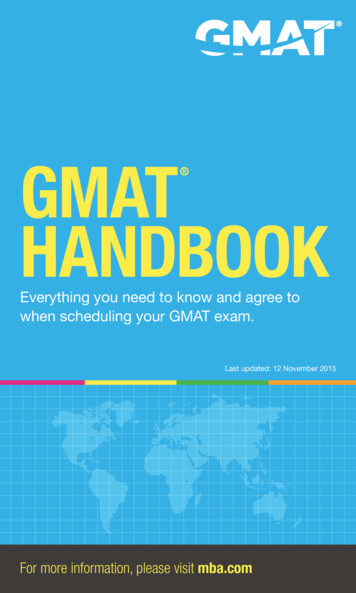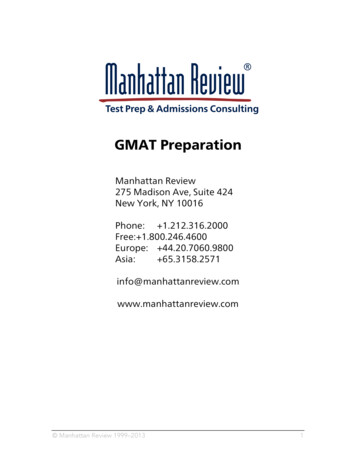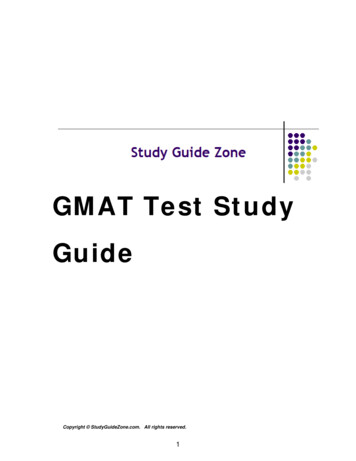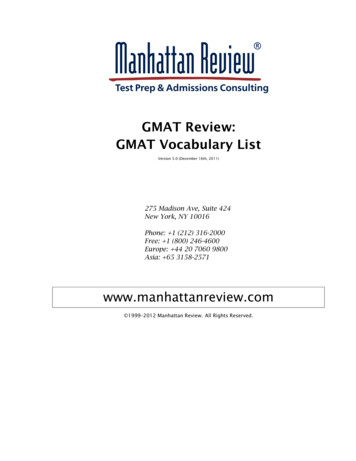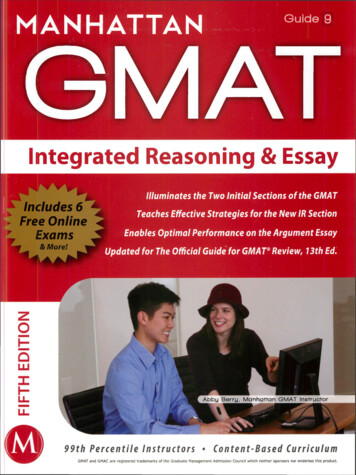
Transcription
MANHATTANGuide 9GMATIntegrated Reasoning & Essay Includes 6 *Free Online -4ExamsrnmmIlluminates the Two Initial Sections of the GMATTeaches Effective Strategies for the New IR SectionEnables Optimal Performance on the Argument Essay,Updated for The Official Guide for GMAT Review 13th Ed.A b b y B e rry , M a n h a tta n G M A T In s tru c to r9 9th P e rc e n tile In stru c to rs C ontent-B ased CurriculumGMAT and GMAC are registered trademarks of the Graduate Management Admission Council which neither sponsors nor endorses this product.
MANHATTAN GMATIntegrated Reasoning& EssayGMAT Strategy GuideThis guide covers the Integrated Reasoning and Essay sections on theGMAT. Master advanced new question types, and discover strategies foroptimizing performance on the essay.
Integrated Reasoning & Essay GMAT Strategy Guide, Fifth Edition10-digit International Standard Book Number: 1-935707-83-313-digit International Standard Book Number: 978-1-935707-83-7elSBN: 978-1-937707-10-1Copyright 2012 MG Prep, Inc.ALL RIGHTS RESERVED. No part of this work may be reproduced or used in any form orby any means—graphic, electronic, or mechanical, including photocopying, recording,taping, web distribution—without the prior written permission of the publisher,MG Prep Inc.Note: GMAT, Graduate M anagem ent Admission Test; Graduate Managem ent AdmissionCouncil, and GMAC are all registered trademarks of the Graduate Management AdmissionCouncil, which neither sponsors nor is affiliated in any way with this product.Layout Design: Dan McNaney and Cathy HuangCover Design: Evyn Williams and Dan McNaneyCover Photography: Alii UgosoliCl i c t a i m a d i C\ FOPF TPYINITIATIVEC e r tifie dC h a in fCustodyPromoting Sustainable Forestrywww.sfiprogram.orgSFl-00756J
INSTRUCTIONAL GUIDE SERIESG D D 03 GMAT Roadmap(ISBN: 97 8-1-935707-69-1)Fractions, Decimals, & Percents(ISBN: 978-1-935707-63-9)Algebra(ISBN: 978-1-935707-62-2)Word Problems(ISBN: 978-1-935707-68-4)Geometry(ISBN: 97 8-1-935707-64-6)SUPPLEMENTALS0annt jNumber Properties(ISBN: 978-1-935707-65-3)Critical Reasoning(ISBN: 978-1-935707-61-5)Reading Comprehension(ISBN: 978-1-935707-66-0)Sentence Correction(ISBN: 978-1-935707-67-7)Integrated Reasoning & Essay(ISBN: 978-1-935707-83-7)GUIDE SERIESMath GMAT Supplement GuidesVerbal GMAT Supplement GuidesFoundations of GMAT MathFoundations of GMAT Verbal(ISBN: 978-1 -935707-59-2)Advanced GMAT Quant(ISBN: 97 8-1-935707-15-8)Official Guide Companion(ISBN: 978-0-984178-01-8)(ISBN: 978-1 -935707-01 -9)
MANHATTANGMATApril 24th, 2012Dear Student,Thank you for picking up a copy of Integrated Reasoning & Essay. I hope this book provides just the guidance you needto get the most out of your GMAT studies.As with most accomplishments, there were many people involved in the creation of the book you are holding. Firstand foremost is Zeke Vanderhoek, the founder of Manhattan GMAT. Zeke was a lone tutor in New York when hestarted the company in 2000. Now, 12 years later, the company has instructors and offices nationwide and contributesto the studies and successes of thousands of students each year.Our Manhattan GMAT Strategy Guides are based on the continuing experiences of our instructors and students. Forthis volume, we are particularly indebted to Liz Ghini-Moliski, Dave Mahler, and Stacey Koprince. Dave deserves spe cial recognition for his contributions over the past number of years. Dan McNaney and Cathy Huang provided theirdesign expertise to make the books as user-friendly as possible, and Noah Teitelbaum and Liz Krisher made sure allthe moving pieces came together at just the right time. And there’s Chris Ryan. Beyond providing additions and editsfor this book, Chris continues to be the driving force behind all of our curriculum efforts. His leadership is invaluable.Finally, thank you to all of the Manhattan GMAT students who have provided input and feedback over the years. Thisbook wouldn’t be half of what it is without your voice.At Manhattan GMAT, we continually aspire to provide the best instructors and resources possible. We hope thatyou will find our commitment manifest in this book. If you have any questions or comments, please email me atdgonzalez@manhattanprep.com. I’ll look forward to reading your comments, and I’ll be sure to pass them along toour curriculum team.Thanks again, and best of luck preparing for the GMAT!Sincerely,Dan GonzalezPresidentManhattan GMATwww.manhattangmat.com138 West 25th St., 7th Floor NY, NY 10001Tel: 212-721-7400Fax:646-514-7425
HOWTO ACCESS YOUR ONLINE RESOURCESIf you.are a registered Manhattan GMAT studentand have received this book as part of your course m aterials, you have AUTOMATICaccess to ALL of our online resources. This includes all practice exams, question banks,and online updates to this book. To access these resources, follow the instructions inthe Welcome Guide provided to you at the start of your program. Do NOT follow theinstructions below.purchased this book from the Manhattan GMAT online storeor at one of our centers1. Goto: http://www.manhattangmat.com/practicecenter.cfm.2. Log in using the username and password used when your account was set up.purchased this book at a retail location1. Create an account with Manhattan GMAT at the website: https://www.m anhattangm at.com /createaccount.cfm .2. Goto: http://www.m anhattangm at.com /access.cfm .3. Follow the instructions on the screen.Your one year of online access begins on the day that you register your book at the above URL.You only need to register your product ONCE at the above URL. To use your online resources anytime AFTER you have completed the registration process, log in to the following m.Please note that online access is nontransferable. This means that only NEW and UNREGISTERED copies of the bookwill grant you online access. Previously used books will NOT provide any online resources.purchased an eBook version of this book1. Create an account with Manhattan GMAT at the website:https://www.m anhattangm at.com /createaccount.cfm .2. Em ail a copy of your purchase receipt to books@ manhattangmat.com to activateyour resources. Please be sure to use the sam e email address to create an accountthat you used to purchase the eBook.For any technical issues, email books@manhattangmat.com or call 800-576-4628.Please refer to the following page for a description of the online resources that come with this book.
YOUR ONLINE RESOURCESYour purchase includes ONLINE ACCESS to the following:6 Computer-Adaptive Online Practice ExamsThe 6 full-length com puter-adaptive practice exams included with thepurchase of th is book are delivered online using Manhattan GMAT's propri etary com puter-adaptive test engine. The exams adapt to your ability level bydraw ing from a bank of more than 1,200 unique questions of varyingdifficulty levels written by M anhattan GMAT’s expert instructors, all of whomhave scored in the 99th percentile on the Official GMAT. At the end of eachexam you will receive a score, an analysis of your results, and the opportunityto review detailed explanations for each question. You may choose to takethe exam s timed or untimed.The content presented in this book is updated periodically to ensure thatit reflects the GMAT’s most current trends and is as accurate as possible.You may view any known errors or minor changes upon registering foronline access.Im portant Note: The 6 computer adaptive online exams included with the purchase ofth is book are the SAME exam s that you receive upon purchasing ANY book in theM anhattan GMAT Complete Strategy Guide Set.Integrated Reasoning & Essay Online Question BanksThe Bonus Online Question Banks for Integrated Reasoning & Essay consists of extra practice questions(with detailed explanations) that test the variety of concepts and skills covered in this book. These ques tions provide you with extra practice beyond the problem sets contained in this book. You may use ouronline tim er to practice your pacing by setting time lim its for each question in the banks.Online Updates to the Contents in this BookThe content presented in this book is updated periodically to ensure that it reflects the GMAT’s mostcurrent trends. You may view all updates, including any known errors or changes, upon registering foronline access.
TABLE1. Introduction to Integrated Reasoning112. IR Quant213. IR Verbal614. IR Preparation and Review875. The Argument Essay95
Integrated ReasoningIntroduction toIntegrated Reasoning
The Purpose o f the IR SectionDon't Let IR Mess Up the Rest o f Your TestIntegrated Reasoning in DetailThe Calculator
Introduction toIntegrated ReasoningThe new Integrated Reasoning section of the GMAT launches in June 2012. The “IR” section replacesone of the two essays at the beginning o f the test. Like an essay, Integrated Reasoning takes 30 minutes,so the whole exam takes the same amount of time as before.Old GMATNEW GMATbefore June 2012June 2012 or afterEssay #130 minEssay #230 minQuant75 min37 questionsVerbal Essay30 min R3 0 m inQuant75 min37 questions75 min41 questionsVerbal75 min41 questionsAs the name implies, Integrated Reasoning asks you to do both math and verbal thinking as youanswer questions based on 12 prompts, or sets of information for you to analyze. Many prompts andquestions have new, unfamiliar formats.IR is separately scored. Your performance on IR does not affect your score on any other section. The IRscoring system will be finalized by April 2012. Check our site for updates.
Introduction to Integrated Reasoning1Old GMAT ScoresEssaysQuantNEW GMAT Scores0-6Essay0-6IRTBDQuant0 -6 0subscore0 -6 0subscoreOverallOverall 2 0 0 -8 0 0 200 - 800Verbal0 -6 041 questionssubscoreJVerbal0 -6 041 questionssubscoreHow schools will interpret the results is somewhat uncertain. Most likely, admissions officers will putonly moderate weight on the IR score at first. Don’t count on them ignoring the score altogether, but atleast initially, an IR result will probably be interpreted as just another piece of data, one additional ele ment in an applicant s mosaic.Over time, admissions officers will observe how performance on the IR section correlates with aca demic performance in business school. The predictive power of the IR score cant be entirely known inadvance. Thus, the role and importance of IR in the admissions process will not be completely clear forsome time.The Purpose of the IR SectionMost business schools use case studies to teach some or even most topics. Cases are true histories ofdifficult business situations: they include vast amounts of real information, both quantitative and ver bal, that you must sort through and analyze to glean insights and make decisions.The old GM AT has been a decent predictor of academic success in business school; thus, it must mea sure the quant and verbal skills required for case analysis.What the old GM AT could not fully do is mirror two key aspects of case analysis: math-verbal inte gration and the flood of real-world data. The IR section puts a new, unique focus on these aspects.O f course, any word problem on GMAT Quant involves math-verbal integration, and a few CriticalReasoning questions require you to draw numeric conclusions. However, you never have to apply hardquantitative thinking to numbers embedded in a Reading Comprehension passage. On the IR section,you will have to do such thinking.Likewise, real-world data in excess quantity is new to the GMAT. In fact, current Quant problemsinclude extraneous information so rarely that you can often break logjams by asking yourself what datayou haven t used yet. Moreover, the numbers in the Quant section are rigged for easy computation byhand, once you see the trick.M ANHATTANGMAT
Introduction to Integrated ReasoningIn contrast, Integrated Reasoning gives you giant tables of ugly numbers, many of which you’ll nevercompute with. And you’ll need to use the provided calculator to save time as you crunch messy decimals.It is true that Reading Comprehension passages include lots of miscellaneous facts that you won’t beasked about, but IR takes this fun feature to the next level.In short, the new IR section seeks to measure your ability to do case analysis in business school.How? By asking you to do mini-case analysis on the GMAT.Integrated Reasoning is very “business-school”-like, so it might seem that admissions officers would payparticular attention to the score.Remember two things, though: IR is brand-new, and it’s only 30 minutes long.We believe that for a significant period of time at minimum, your performance on the standard Quantand Verbal sections (the 200-800 score) will be substantially more important than your performanceon IR.Don't Let IR Mess Up the Rest of Your TestUnfortunately, for most people the Integrated Reasoning section is much harder than the Issue essaythat it replaces. You have to absorb a ton of new data of various types, repeatedly shift mental gears, andmake a swarm of decisions. all in 30 minutes.Twelve data-intensive prompts, with at least one question per prompt, in just 30 minutes?That’s some intense time pressure. You will have to work fast and avoid rat holes. Most importantly—you will have to recover very quickly for the rest of the exam.Unfortunately, after the IR section, your brain will be spent. How should you prepare to deal with thismental exhaustion? Do the following: Build stamina in advance. Take more than one full practice exam with the IR sectionincluded. During review, study the fast and easy way to do each problem. Then drill that way intoyour head. Don’t be too cool to use the calculator. Replenish your brain’s food— glucose. During the break after IR, drink Gatorade or asimilar energy drink. Nothing else will work faster to counter so-called “decision fatigue”and restore your mental willpower. As you go to your locker, only get a beverage or an en ergy bar. Do not touch your cell phone or anything else—your exam will be immediatelydisqualified if you do.MANHATTANGMAT
ntroduction to Integrated Reasoning1IR can mess up the rest of your test in another way. Coming out of IR, you will have to make a coupleof small but critical adjustments to the way you solve quant and verbal problems.Think of roller skates and roller blades. You accelerate and turn on them basically the same way, butyou stop differently. In fact, the similarity of roller skates and roller blades can be dangerous, if you mixup which ones you’re zooming around on.The new GMAT makes you wear roller skates for IR, then switch to roller blades for Quant and Verbal.Be aware of the following differences, so you don’t wipe out!GMAT QuantAs you go from Integrated Reasoning to the Quant section, you have to switch from using a calculatorto estimating or applying other computation tricks.On IR, you sh ou ld use the calculator, because IR questions sometimes demand that you make computa tions with nasty numbers to within 10-15% of the right answer. Why waste time and energy estimat ing when you have a calculator handy? (Of course, don’t turn off your number sense; it’s nice to spotridiculous results that come from keystroke errors.)When you move to the Quant section, the calculator is taken away. It feels worse to lose something youonce had, but a v o id g ettin g fru stra ted . Just remember that the numbers are now rigged. There must be ashortcut through estimation or some other method that you can apply by hand.You must also switch from ignoring extra data to never ignoring data.On IR, you have to sift through mounds of given information. To do so quickly, you have to see w hatk ind of information you’re given, but you should not read every last digit carefully.On GM AT Quant, you are alm ost n ever given unnecessary information. Even long word problems avoidproviding extraneous facts. When you get stuck, you should check to see that you’ve used everythinggiven to you.GMAT VerbalWhen you get to the Verbal section, you have to stop reading between the lines. On Integrated Reason ing, you sometimes have to make very subtle inferences from real-world communications, such as emailexchanges. Dialogues of any kind are very rare in Verbal, but they occur with some regularity in the IRsection.As you interpret a dialogue, you have to infer the mindsets of the speakers or writers from what is said,how it is said, and even what is n ot said. You also have to pick up on how these mindsets may change asthe dialogue progresses. This sort of IR content reflects social relationships, much like a scene in a playor on TV.M AN H ATTANGMAT
Chapter 1Introduction to Integrated ReasoningIn contrast, on GM AT Verbal you read plain text: expository passages and arguments. The mindset ofthe author is much simpler to interpret. In fact, you should turn off the ear for social nuances that youhad activated for IR. Avoid reading too much into the text on Verbal. Stay close to the actual wordson the screen.In both IR and Verbal, the precise use of language matters a great deal. But in IR, the textual proof canbe implicit, andyou’ll need to be sensitive to social context. On Verbal, there’s little social context, andthe proof is made more explicit.Integrated Reasoning in DetailThe Integrated Reasoning section contains 12 prompts, each associated with one or more questions(just as Reading Comprehension passages are). You will almost certainly not be asked more than threequestions for any given prompt.There are four types of prompts. Note that the first two types are interactive:1. Multi-Source Reasoning2. Table AnalysisSwitch between two or three tabs of information.Sort a table by any column using a pull-downmenu.Proposal Objectives V BudgetSort byEmail from manager to staffApril 7 , 1:03pmThe results of the recentmarketing survey have ville412,390Baskerville287,840Camelot123,0503 -7 more columns.4 -2 0 more rowsInteractive3. Graphics Interpretation4. Two-Part AnalysisInterpret a graph or other image.Answer a two-part question.Here is some information.The form at o f this prom pt isnot interesting. However, thequestion type associated withthis prom pt is interesting.StaticNANHATTANGMAT17
Introduction to Integrated Reasoning1There are also four types of questions you can be asked: traditional multiple-choice and three new typesthat demand two or more responses per question.A. Traditional Multiple ChoicePick one of five choices, as usual.B. Either/Or Statements*Choose one side or the other for each of threestatements.What is the increase. ?o 10% 20%o 30%o 40%o 50%TrueFalseo § Statement 1 oStatement 20 § Statement 3C. Drop-Down StatementsD. Two-Part QuestionMake one choice from a drop-down menu forMake one choice in each of two columns.each of two statements.The slope is positiveThe volume is Select.100 cc200 cc300 cc400 ccI*Co. ACo. B0ooooo o oooProfit- 200 million- 100 million 0 100 million 200 million 300 millionDon’t let these fancy question types throw you. They’re just slightly different “looks.” In all cases, yousimply answer the question you’re asked.What really makes these new types harder is that you have to give two or more responses per ques tion. This means you have to move evenfaster to get through them. It is likely that the GMAT willaward partial credit in some fashion.Also, don’t mix up Either/Or Statements with Two-Part Questions. With Either/Or Statements, youmake one choice in each row. With Two-Part Questions, you make one choice in each column.* The GMAT calls this type “multiple-dichotomous choice.” We figured we’d come up with a nicer name.MANHATTANGMAT
Introduction to Integrated ReasoningChiHere’s how the prompts and question types match up:PromptQuestion1. Multi-Source ReasoningA. Traditional Multiple ChoiceProposal " ObjectivesY"BudgetQuestions per Prompt What is th e increase.E m a il fr o m manager to s ta ffo 10%Probably 1 20%A p r il 7 , 1:03pmo 30%o 40%o 50%The results o f th e recentmarketing survey have beencom piled.B. Either/Or Statements2. Table AnalysisSort by Select.Probably 2Statement 23 statements 3 responsesStatement 3(1 per row)B. Either/Or Statements PopulationCityStatement 1Just 1 per prompt3 - 7 m o re c o lu m n sAlphaville412,390Baskerville287,8403 statements 3 responsesCamelot123,050(1 per row)4 - 2 0 m o re row s3. Graphics InterpretationC. Drop-Down StatementsThe slope is positive100cc200 cc300 cc400 ccThe graph above is ascatterplot w ith 30 points.4. Two-Part Analysis .Just 1 per prompt2 responses (1 per statement)D. Two-Part QuestionHere is some information.The fo r m a t o f th is p r o m p t isn o t in te re s tin g . H o w e ve r, th eq u e s tio n ty p e a s s o cia te d w ithth is p r o m p t Is in te re s tin g .Co. ACo. Bo0oooo Profito 0 100 million oo0 300 million- 200 million- 100 million 200 millionJust 1 per prompt2 responses (1 per column. Note:T h e sam e answer could be right forboth columns!)Unlike the Quant and Verbal sections, IR is not adaptive: it does not get harder or easier, depending onhow you answer. As you proceed through the IR section, you cannot go back to earlier questions.The relative composition of the IR section — how many prompts of each type, how many questions ofeach type— is still not certain as this book goes to press. It is likely that there will be fe w e r in teractiveprompts (Multi-Source Reasoning and Table Analysis) than static prompts (Graphics Interpretation andTwo-Part Analysis), since the interactive prompts are more complex and time-consuming to deal with.Again, check the website for updates.MANHATTANGMAT
Introduction to Integrated ReasoningThe CalculatorA simple calculator is available to you at all times on Integrated Reasoning.Click the Calculator link in the upper left corner of the window. The calculator floats above the ques tion and disables it temporarily. You can drag the calculator anywhere on the screen.Answer windowTells you that anumber is inmemory XClear memory(no comma betweenthousands)Calculator125000.25 M X[Backspace] [CE] [CClear an entry(CE) or clearcompletely (C)]000000Recall anumber from,memory[ MR ]0 0 0 0 0 *.0 000000 00O00Store anumber in memorytAdd a number towhat's already inmemoryTake a squarerootIndicate that a number is apercentt---------fChange signAdd, subtract,(type "50 10% "to get "55") Take thereciprocal(divide into 1)multiply, ordivideYou can click buttons with your mouse or use the keyboard, once you’ve clicked in the answer window.Not every button has a keyboard equivalent— only the numbers, arithmetic operations, backspace,decimal point, and percent sign. The equals sign ( ) works, but not the Enter key.The calculator is not a luxury. IR problems force you to make fast calculations with messy numbers.Practice using the calculator and plan to use it on the exam to avoid mental fatigue, which leads to sillyerrors. Write or sketch out your math on paper first, so that you execute the right operations.M AN HATTANGMAT
Integrated ReasoningIR Quant
How to Tackle IR Quant: Understand-Plan-SolveExample ProblemsQuant Topics EmphasizedStatisticsTypes o f Tables and GraphsIn Brief
IR QuantThe math side of the Integrated Reasoning section differs from that of the GMAT Quant in a fewsubtle but important ways. Exaggerating the differences a bit, we can describe the Integrated Reasoningas “real world,” while GM AT Quant is more based on “math tricks.”GMAT Quant - M ath TricksIntegrated Reasoning - R eal WorldNumbers are ugly, as if from the real world. The Numbers are rigged. Once you see how, you canmanipulate them nicely. No calculator is provid calculator provided on-screen is useful, evennecessary. Results are sometimes “real,” as if toed— or needed. Results are often artificial, likeanswer a business question.those for a math puzzle.Example: 0,478 billion -s- 0.763% ? 0.478 0.00763 62.7 billionExample: 317- 316 315 ?Extra information is often provided. You mustExtra information is rarely provided. If you didn’tsift the data to find whats relevant. 315(9 - 3 1 ) 3I5(7)use everything, you probably made a mistake.Your task is to follow a chain of deductions.Example: In the following big table, how manycities have both 3% job growth and 8%Example: x y z but x2 y2 z 2, which of theunemployment?following must be positive?Many cities in the table wontfit.Use all the constraints given.Necessary data is provided in many differentTables and charts are provided infrequently.forms, such as tables and charts. Numbers can be Numbers are embedded in smaller quantities ofembedded in lots of descriptive text.text, such as short word problems.
Chapter 2IRQuantIn short, you have a lot of ugly numbers, graphical data, and text. You’ve got a calculator, but not a lotof time.What does all this mean? A blessing in disguise: They cant ask for anything that takes a long timeto compute. IR math will be more focused than the GMAT Quant section. Topics suchas percents will be emphasized at the expense of other topics, such as numberproperties and geometry.So, how do you deal with IR math?First and foremost, prepare for GMAT Quant. All the practice that you are doing with word problemsand FDP questions (Fractions, Decimals, and Percents) is perfectly applicable here. You are killing twobirds with one stone.Second, you need a good problem-solving process.How to Tackle IR Quant: Understand-Plan-SolveHere is a universal four-step process for Integrated Reasoning math:1.Understand the prompt.2.Understand the question.3.Plan your approach.4.Solve the problem.This process works well for GMAT Quant, too (although those prompts are shorter, so you can usuallycombine steps 1 and 2).If you are already comfortable with reading charts and manipulating information from them, you canbe more relaxed about this process. However, you should not discard it entirely. A simple, structuredchecklist reduces the likelihood of a disaster if something unexpected happens.Airline pilots, fire fighters, and emergency medical personnel have ultra-clear processes for dealing withstressful situations. You should as well.1. Understand the PromptAs you scan the given data, ask yourself “What and So What”: 24What is this?So What about this?M ANHATTANGMAT
IRQuant“What is this?” directs your attention: What is in this chart, this row, or this column? What do these points represent? Read titles and labels.What kind of graph is this— pie, column, line, bubble,etc.?What kind of numbers are these— percents, ranks, or absolute quantities, such as dollarsor barrels?Don’t forget to glance over accompanying text. Valuable totals or other numbers can be buried in footnotes.“So What about this?” keeps you thinking about the big picture: How is this information organized? How does it all fit together? Draw connections. Why is this part here? What purpose does it serve, relative to everything else? Note key similarities and differences, but do not try to master detail.You might be tempted to skip this “understand the prompt” step and jump into answering the question.But the time you take to scan the data and understand it will help you to solve the problem faster— andbetter.2. Understand the QuestionTake your time reading the question before you try to solve it. What are they asking for precisely? Thewording can trick you. For instance, you might think that you must use an advanced, time-consumingtechnique, or that you need information that you really don’t need.You may hear the clock ticking away, but don’t let it panic you. No one can solve these problems with out taking time up front, including Manhattan GMAT instructors. If you don’t spend the time, youmight chase an illusory rabbit down a rabbit hole. We know. We’ve chased that rabbit before, too!3. Plan Your ApproachJust as on GMAT Quant, think about different ways to solve the problem. One way is usually easierthan all the others— look for it.Many methods work similarly for both IR math and GMAT Quant: Reorganize and plan on paper:- With IR math, you won’t want to copy everything down, but don’t try to figuretoo much out in your head.- Translate the work to specific tasks. For tricky computations on IR, rememberthat you have a calculator. Once you’ve plotted out your numbers, call up theon-screen calculator and use it.M ANHATTANGMAT
IRQuant Create variables as needed, and remember algebra traps:- For instance, on a two-part problem, you might need to solve for a “combo” oftwo variables, rather than for each variable separately. Consider alternatives to algebra:- For instance, plug real numbers or work backwards from the answer choices. As you test cases on a “true/false” question, play devils advocate.- Once you have an example going one way, look for counterexamples going theother way.- You often do the same thing on Data Sufficiency. As an alternative to brute force, look for shortcuts:- For instance, rather than count lots of cases that fit some criteria, count thecases that doritfit and subtract from the total. This “1 - x* trick is useful onGMAT Quant as well.4. Solve the ProblemNow execute your plan of attack. If you’ve done the first three steps right, solving should be prettystraightforward. O f course, you still need to take care. Write things down clearly, so that you don’tmake silly mistakes. Once you have figured out what the question really wants, the task is sometimessuper-easy: count the dots in this quadrant! But you’d hate to mess up at this point. For instance, doalgebraic manipulations on paper, and don’t skip steps.Here are a couple of tips specific to IR: When you extract numbers from a graph, write them down with labels. If you are pullinga point from a scatterplot, use (x, y) notation. Don’t reverse x and y\ If you have to esti mate, do your best in the moment and keep going. To count entries in a sortable table, re-sort the table so tha
MANHATTAN GMAT April 24th, 2012 Dear Student, Thank you for picking up a copy of Integrated Reasoning & Essay. I hope this book provides just the guidance you need t
